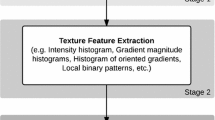Abstract
Textural properties of normal and tuberculosis posterior-anterior chest radiographs were looked into in this investigation. The proposed computerized scheme segmented the lung field of interest using a user-guided snake algorithm and extracted the corresponding pixel data. For both normal and tuberculosis radiographs, the grayscale intensity distribution within the region of interest was analyzed to study their respective characteristics, and fed to classifiers for automated classification. Statistically the tuberculosis infected radiographs manifested a higher variance, third moment, entropy and a lower mean value in their intensity distributions, compared to their normal peers. The greater disparities between a particular radiograph and the confidence interval determined by our normal groups on some of the features were observed to be related to the level of haziness at the upper lobe. Lastly, the C4.5 (a decision tree based classifier)-adaboost achieved an accuracy of 94.9% in normal-tuberculosis classification. An integrated index, called tuberculosis index (TI), is proposed based on texture features to discriminate normal and tuberculosis chest radiographs using just one index or number. We hope this TI can be used as an adjunct tool by the radiographers in their daily screening.







Similar content being viewed by others
References
TB Alliance, “2010 Annual Report,” 2010.
TB Alliance. http://www.tballiance.org/why/tb-threat.php .
Shen, R., Cheng, I., and Basu, A., A hybrid knowledge-guided detection technique for screening of infectious pulmonary tuberculosis from chest radiographs. IEEE Trans. Biomed. Eng. 57:2646–2656, 2010.
Lodwick, G. S., Computer-aided diagnosis in radiology: A research plan. Invest. Radiol. 1:72–80, 1966.
Lodwick, G. S., Keats, T. E., and Dorst, J. P., The coding of Roentgen images for computer analysis as applied to lung cancer. Radiology 185–200, 1963.
Van Ginneken, B., Ter Haar Romeny, B. M., and Viergever, M. A., Computer-aided diagnosis in chest radiography: A survey. IEEE Trans. Med. Imaging 20:1228–1241, 2001.
van Ginneken, B., Katsuragawa, S., ter Haar Romeny, B. M., Kunio, D., and Viergever, M. A., Automatic detection of abnormalities in chest radiographs using local texture analysis. IEEE Trans. Med. Imaging 21:139–149, 2002.
Arzhaeva, Y., Tax, D. M. J., and van Ginneken, B., Dissimilarity-based classification in the absence of local ground truth: Application to the diagnostic interpretation of chest radiographs. Pattern Recogn 42:1768–1776, 2009.
Tourassi, G. D., Journey toward computer-aided diagnosis: Role of image texture analysis1. Radiology 213:317–320, 1999.
Ganeshan, B., Miles, K. A., Young, R. C. D., and Chatwin, C. R., Texture analysis in non-contrast enhanced CT: Impact of malignancy on texture in apparently disease-free areas of the liver. Eur. J. Radiol. 70:101–110, 2009.
Kass, M., Witkin, A., and Terzopoulos, D., Snakes: Active contour models. Int. J. Comput. Vis. 1:321–331, 1988.
Xu, C., and Prince, J. L., Snakes, shapes, and gradient vector flow. IEEE Trans. Image Process. 7:359–369, 1998.
Samei, E., et al., Effects of anatomical structure on signal detection. In: Beutel, J. (Ed.), Handbook of Medical Imaging: Physics and Psychophysics. International Society for Optical Engineering, Washington, pp. 655–682, 2000.
Waring, J. J., and Wasson, W. W., The imperfections of the stereoscopic manœuvre in radiography of the chest. Radiology 6:198–203, 1926.
Nodine, C. F., Krupinski, E. A., and Kundel, H. L., A perceptually-based algorithm provides effective visual feedback to radiologists searching for lung nodules. In: Visualization in Biomedical Computing, 1990., Proceedings of the First Conference on, 1990, pp. 202–207.
Hessel, S. J., Herman, P. G., and Swensson, R. G., Improving performance by multiple interpretations of chest radiographs: Effectiveness and cost. Radiology 127:589–594, 1978.
Abe, H., MacMahon, H., Engelmann, R., Li, Q., Shiraishi, J., Katsuragawa, S., Aoyama, M., Ishida, T., Ashizawa, K., Metz, C. E., and Doi, K., Computer-aided diagnosis in chest radiography: Results of large-scale observer tests at the 1996–2001 RSNA scientific assemblies1. Radiographics 23:255–265, 2003.
Monnier-Cholley, L., MacMahon, H., Katsuragawa, S., Morishita, J., Ishida, T., and Doi, K., Computer-aided diagnosis for detection of interstitial opacities on chest radiographs. Am. J. Roentgenol. 171:1651–1656, 1998.
Ashizawa, K., MacMahon, H., Ishida, T., Nakamura, K., Vyborny, C., Katsuragawa, S., and Doi, K., Effect of an artificial neural network on radiologists’ performance in the differential diagnosis of interstitial lung disease using chest radiographs. Am. J. Roentgenol. 172:1311–1315, 1999.
Abe, H., Ashizawa, K., Li, F., Matsuyama, N., Fukushima, A., Shiraishi, J., MacMahon, H., and Doi, K., Artificial neural networks (ANNs) for differential diagnosis of interstitial lung disease: Results of a simulation test with actual clinical cases1. Acad. Radiol. 11:29–37, 2004.
Tan, J. H., Ng, E. Y. K., and Acharya, U. R., Study of normal ocular thermogram using textural parameters. Infrared Phys Tech 53:120–126, 2009.
Acharya, U. R., Dua, S., Du, X., Sree, V. S., and Chua, K. C., Automated diagnosis of glaucoma using texture and higher order spectra features. IEEE Trans. Inf. Technol. Biomed. 15(3):449–455, 2011.
Acharya, U. R., Ng, E. Y. K., Tan, J. H., Sree, V. S., Ng, K. H., An integrated index for the identification of diabetes retinopathy stages. J. Med. Syst., 2011 (In Press: doi:10.1007/s10916-011-9663-8).
Acharya, R. U., Faust, O., Alvin, A. P. C., Sree, V. S., Molinari, F., Saba, L., Andrew Nicolaides, A., Suri, J. S. Symptomatic vs asymptomatic plaque classification in carotid ultrasound. J. Med. Syst. 2010 (In Press: doi:10.1007/s10916-010-9645-2).
Acharya, U. R., Ng, E. Y. K., Tan, J. H., Sree, V. S., Thermography based breast cancer detection using texture features and support vector machine. J. Med. Syst. 2010 (In Press: doi:10.1007/s10916-010-9611-z)
Author information
Authors and Affiliations
Corresponding author
Electronic supplementary material
Below is the link to the electronic supplementary material.
ESM 1
(XLS 31 kb)
Rights and permissions
About this article
Cite this article
Tan, J.H., Acharya, U.R., Tan, C. et al. Computer-Assisted Diagnosis of Tuberculosis: A First Order Statistical Approach to Chest Radiograph. J Med Syst 36, 2751–2759 (2012). https://doi.org/10.1007/s10916-011-9751-9
Received:
Accepted:
Published:
Issue Date:
DOI: https://doi.org/10.1007/s10916-011-9751-9




